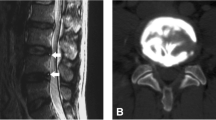Abstract
Purpose
It is questionable whether an annular tear (AT) is a predictor for accelerated degeneration of the intervertebral discs. The aim of the present study was to answer this question via a matched case–control study design that reliably eliminates potential confounders.
Materials
Presence or absence of AT, defined as a hyperintense lesion within the annular fibrosus on T2-weighted non-contrast MRI images, was documented in 450 intervertebral lumbar discs of 90 patients who could be followed up for at least 4 years with MRI. Discs with an AT (n = 36) were matched 1:1 to control discs according to the level, degree of initial disc degeneration on MRI (both Pfirrmann grade median 4, range 3–4), age (59.5 ± 15.0 versus 59.3 ± 14.6 years), BMI (26.7 ± 4.4 versus 26.9 ± 4.4 kg/m2) and interval to the follow-up MRI (4.8 ± 0.9 versus 5.1 ± 0.8 years). The degree of disc degeneration after a minimum of 4 years was graded on the follow-up MRI in both groups according to the Pfirrmann classification.
Results
One-fourth (25 %) of the 36 discs with an AT on the initial MRI exam progressed in degeneration. This was similar to the rate of the matched control discs with no AT, in which also around one-fourth (22 %) showed a progression of degeneration (p = 1.00), also without any difference in the degree of degeneration.
Conclusion
Discs with a Pfirrmann grade >2 with an AT, defined by a hyperintense signal intensity on MRI, are not prone to accelerated degeneration if compared to discs without an AT. Therefore, the presence of an AT per se does not predict accelerated disc degeneration.

Similar content being viewed by others
References
Yu SW, Sether LA, Ho PS et al (1988) Tears of the anulus fibrosus: correlation between MR and pathologic findings in cadavers. AJNR Am J Neuroradiol 9:367–370
Park WM, McCall IW, O’Brien JP, Webb JK (1979) Fissuring of the posterior annulus fibrosus in the lumbar spine. Br J Radiol 52:382–387. doi:10.1259/0007-1285-52-617-382
DePalma MJ, Lee J-E, Peterson L et al (2009) Are outer annular fissures stimulated during diskography the source of diskogenic low-back pain? An analysis of analgesic diskography data. Pain Med 10:488–494. doi:10.1111/j.1526-4637.2009.00602.x
Peng B, Hou S, Wu W et al (2006) The pathogenesis and clinical significance of a high-intensity zone (HIZ) of lumbar intervertebral disc on MR imaging in the patient with discogenic low back pain. Eur Spine J 15:583–587. doi:10.1007/s00586-005-0892-8
Carragee EJ, Paragioudakis SJ, Khurana S (2000) 2000 Volvo Award winner in clinical studies: lumbar high-intensity zone and discography in subjects without low back problems. Spine 25:2987–2992
Sharma A, Pilgram T, Wippold FJ (2009) Association between annular tears and disk degeneration: a longitudinal study. AJNR Am J Neuroradiol 30:500–506. doi:10.3174/ajnr.A1411
Bernard TNJ (1990) Lumbar discography followed by computed tomography: refining the diagnosis of low-back pain. Spine 15:690
Osti OL, Fraser RD (1992) MRI and discography of annular tears and intervertebral disc degeneration. A prospective clinical comparison. Bone Joint J 74:431–435
Kornberg M (1989) Discography and magnetic resonance imaging in the diagnosis of lumbar disc disruption. Spine 14:1368
Pfirrmann CW, Metzdorf A, Zanetti M et al (2001) Magnetic resonance classification of lumbar intervertebral disc degeneration. Spine 26:1873–1878
Ross JS, Modic MT, Masaryk TJ (1990) Tears of the anulus fibrosus: assessment with Gd-DTPA-enhanced MR imaging. AJR Am J Roentgenol 154:159–162
Hilton RC, Ball J, Benn RT (1980) Annular tears in the dorsolumbar spine. Ann Rheum Dis 39:533–538. doi:10.1136/ard.39.6.533
Smith BMB, Hurwitz ELE, Solsberg DD et al (1998) Interobserver reliability of detecting lumbar intervertebral disc high-intensity zone on magnetic resonance imaging and association of high-intensity zone with pain and anular disruption. Spine 23:2074–2080
Acknowledgments
The following Grant supports are acknowledged: Department fund of the MRI Department, Hospital for Special Surgery, USA, and individual funding of Swiss National Foundation (N.F. PBZHP3_143674); individual funding of Swiss National Foundation (N.F. PBZHP3_143674).
Conflict of interest
None.
Author information
Authors and Affiliations
Corresponding author
Rights and permissions
About this article
Cite this article
Farshad-Amacker, N.A., Hughes, A.P., Aichmair, A. et al. Is an annular tear a predictor for accelerated disc degeneration?. Eur Spine J 23, 1825–1829 (2014). https://doi.org/10.1007/s00586-014-3260-8
Received:
Revised:
Accepted:
Published:
Issue Date:
DOI: https://doi.org/10.1007/s00586-014-3260-8




